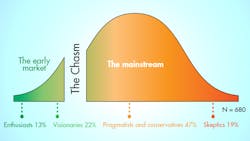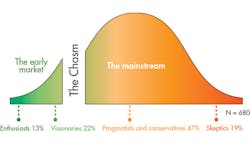This file type includes high-resolution graphics and schematics when applicable.
Disruptive technologies are the hot topic in manufacturing today, garnering massive exposure in trade media. IT solutions like Big Data, cloud deployment, 3D printing, and Internet of Things are being touted for their game-changing potential. Despite the enthusiastic rhetoric of the IT community, some manufacturers seem to be saying, “Wait a minute, we’re not convinced.”
IDC Manufacturing Insights recently published a report that says 15% of manufacturers surveyed have started implementing advanced digital technologies. That’s all. Despite the relatively low adoption rate to date, IDC’s experts still forecast that number will hit 65% by 2020.
Other manufacturing pundits point to similar slow-start numbers. LNS says that when it comes to Internet of Things adoption, the pragmatists and skeptics (66%) still outnumber the enthusiasts and visionaries (35%) almost two-to-one.
This slow-to-moderate ramp-up causes some to wonder about possible stumbling blocks. What part of the story are manufacturers not ready to embrace? Shouldn’t profit-driven manufacturers be eager for a bottom-to-top makeover and totally new approach to processes?
The answer is “Yes, manufacturers need faster, better, smarter processes to keep up with changing market pressures.” But you also have the naysayers in the back of the room who deserve their moment of acknowledgment. They are the ones who say, “No. We can’t indulge in total disruption.”
Reasons Behind the Hesitation
There may be some logical reasons for a brief period of hesitation or a thoughtful pause before the big leap. First, we must concede manufacturers tend to be pragmatists by their very nature. They make products with three dimensions: weight, mass, and a definable “start/end” production flow. This is the comfort zone for the discrete manufacturer—whether the product is a jet or a blender.
When we ask the manufacturer to embrace a conceptual IoT process flow that takes hundreds of charts to diagram, we might as well be asking an engineering-focused professional to believe in pixie dust. “Show me the proof” is a common refrain to these early meetings.
Then, there’s the overload factor. Manufacturers have been bombarded with IT hype for years. Buzzwords in manufacturing media come and go, sometimes lasting for a brief flash of hype that fizzles then dies, like fireworks in rain. Other breakthrough technologies, like 3D printing, are moving from jaw-dropping shock to mainstream acceptance. From astronauts to grade-school children, many of us have had a hands-on experience “printing” an object, even if it was only a demonstration at a trade show or a classroom project meant to inspire the next generation of engineers.
Despite 3D printing’s “fairy tale comes true” example, manufacturers simply get tired of the continuous waves of “wow technology,” each one promising to be bigger and better than the last. At some point, their tired, overwhelmed ears start to hear nothing more than “blah blah blah buy this.”
Another reason for the hesitation may be the term itself. What exactly is disruptive technology and, more importantly, is disruption supposed to be a good thing?
The term has ominous undertones, doesn’t it? Who wants to have their business operations disrupted? Before tech media latched onto the term, “disruption” was used to describe botched schedules, boisterous protestors, and the loud kid sent to the principal for disrupting class. Most business managers avoided disruptions to dependable workflow cycles. Manufacturers with assembly lines certainly couldn’t risk disruption to the continuous workflow. Could they?
The common business truism, “We’re building the plane while we’re flying it,” certainly applies to technology and manufacturing. Manufacturers need to keep the plane (their plants) flying (operating). They can’t land and be out of commission for a major wing-to-wing overhaul.
Defining Disruption
Technology providers, however, tell manufacturers that disruptive technologies are transforming manufacturing. The description is meant to evoke images of startling new innovations so game-changing that the entire way of doing business will be turned on its side. Old paradigms will be shattered and new transformative processes will need to be invented. Like Dorothy leaving her black and white doldrums, we about to open the door to a new Technicolor world. And there will be no going back.
What specific technologies are causing this hullabaloo? That depends. Definitions differ. One of the first head-exploding concepts to earn the “disruptive” moniker was 3D printing. Big Data, cloud deployment, and the Internet of Things also fall in that category, with IoT promising to be the most substantial. Projections are staggering. While estimates of the global economic impact vary, the numbers are always in the billions.
Do Big Technologies Mean Big Headaches?
Everyone has heard of infamous IT projects that have gone awry, whether seriously over budget and/or over-promised and under-delivered. Reasons can be tossed around ad infinitum, from poor project management to lack of executive buy-in.
There are far more success stories, though. Over the years, the IT community has come close to perfecting the process of implementation. From change management courses to implementation accelerators, the entire deployment stage has become a science in itself. The goal is always to remove barriers, reduce turmoil, and maintain productivity during transition.
Some “disruptive technologies” routinely cause minimal disruption to the day-to-day operations, yet provide big impact. Mobility, social collaboration, and product configuration tools represent examples of powerful solutions that are relatively painless to implement. Since they support and enhance concepts that are already familiar to the user, the learning curve tends to be short. Use of tablets, phones, and social sharing are second nature to the millennial generation, so incorporating these processes into their business world seems natural.
Cloud deployment is another high-impact technology that doesn’t mean major disruption to productivity. In fact, ease of implementation is one of the key benefits of cloud computing. The process typically takes months, far less than the years often associated with heavily modified on-premises solutions.
Actionable Advice
You have seen the quote attributed to the Chinese philosopher Laozi hundreds of times, on anything from calendars to bumper stickers, yet it rings true in the case of technology: “A journey of a thousand miles begins with a single step.” New technology doesn’t have to be overwhelming and intimidating. The process needn’t be a negative disruption.
To take advantage of the many benefits of transformative business software and IT solutions, manufacturers must embark on the journey, even if they only take baby steps. Sprinkle a little pixie dust on the diagrams, click your heels together three times, and say, “I believe.” Leap. They rest will be easy.
Ed Talerico is Industry Director of Aerospace & Defense for Infor.
Looking for parts? Go to SourceESB.
This file type includes high-resolution graphics and schematics when applicable.



